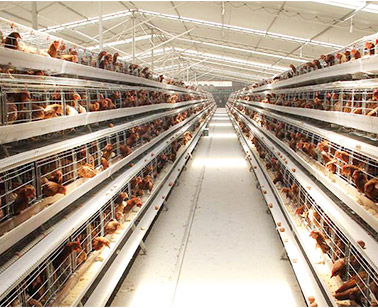Battery cage systems contribute significantly to disease control in poultry farming through several mechanisms:
1. Reduced Exposure to Pathogens
In battery cage systems, birds are housed in enclosed, controlled environments that minimize direct contact with pathogens present in soil, water, and feces. Unlike free-range systems where birds have unrestricted access to potentially contaminated areas, battery cages provide a barrier that reduces the spread of diseases such as avian influenza, Newcastle disease, and coccidiosis.
2. Enhanced Biosecurity Measures
Battery cage systems allow for better implementation of biosecurity protocols. These protocols include strict control over who enters the poultry house, use of footbaths and disinfectant mats at entry points, and isolation of new birds. Such measures reduce the risk of introducing pathogens into the flock and help in maintaining a disease-free environment.

3. Separation of Individual Birds
Each bird in a battery cage system is housed separately or in small groups within individual cages. This isolation reduces the likelihood of disease transmission between birds compared to systems where birds mingle freely. Containment within cages also facilitates easier identification and management of sick birds, minimizing the spread of illnesses within the flock.
4. Improved Monitoring and Management
Battery cage systems allow for more efficient monitoring of bird health and behavior. Farmers can easily observe each bird's condition, feed consumption, and droppings, which are critical indicators of health. Early detection of symptoms allows prompt intervention and treatment, reducing the impact of diseases on the flock's overall health and productivity.
5. Controlled Environment
The controlled environment provided by battery cages extends beyond physical confinement. Factors such as temperature, ventilation, and lighting can be optimized to create conditions that are less favorable for the survival and spread of pathogens. Proper ventilation, for example, helps maintain dry litter and reduces humidity levels that contribute to the proliferation of certain pathogens.
6. Improved Hygiene and Waste Management
Battery cage systems are designed for efficient waste management practices. Droppings fall through the cage floor, minimizing contact between birds and their feces. This reduces the risk of fecal-oral transmission of diseases. Additionally, automated systems for waste removal and cleaning ensure that cages remain clean and hygienic, further reducing the likelihood of disease outbreaks.
7. Reduced Stress Levels
Stress weakens the immune system of poultry, making them more susceptible to diseases. Battery cage systems, when properly managed, can reduce stress factors such as competition for food, water, and space. Each bird has access to its own designated feeding and drinking stations, promoting calm and reducing stress-induced susceptibility to diseases.
Conclusion
Overall, battery cage systems play a crucial role in disease control in poultry farming by minimizing exposure to pathogens, enhancing biosecurity measures, facilitating better monitoring and management of birds, creating a controlled environment, improving hygiene practices, and reducing stress levels among poultry. These factors collectively contribute to maintaining healthier flocks, reducing disease prevalence, and optimizing overall productivity and profitability in poultry farming operations.
